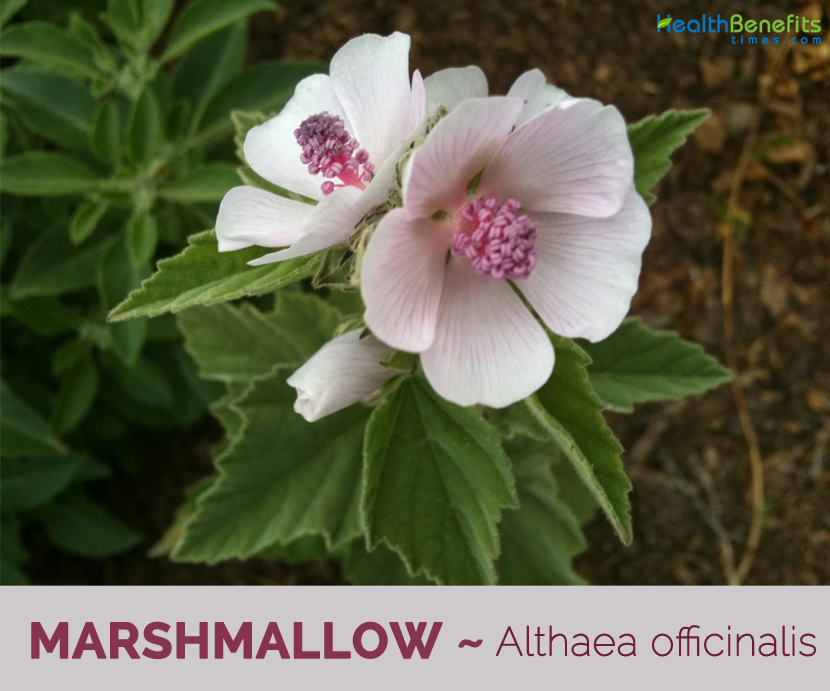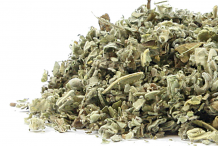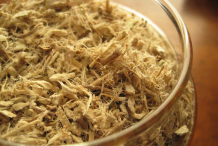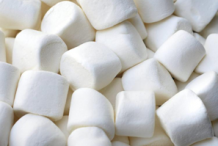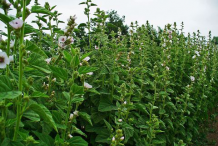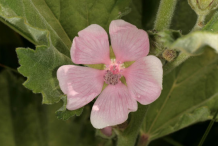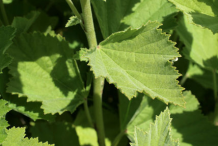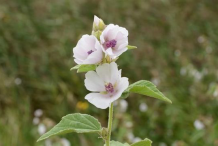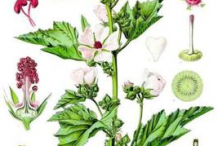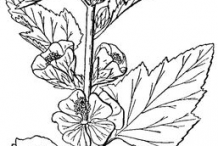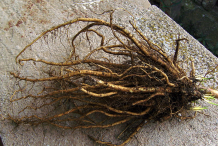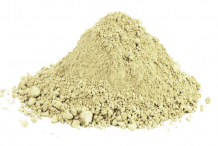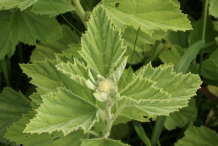This is the plant that is processed to create the well-known marshmallows that you add to desserts and hot chocolate, but the root has been used for medicinal purposes for thousands of years. Dating back to ancient Egypt, marshmallow root has been cultivated and applied due to its impressive nutrient content, which includes starch, pectin, various antioxidants, organic acids and natural sugars. It is used as a medicinal plant and ornamental plant. A confection made from the root since ancient Egyptian time evolved into today’s marshmallow treat.
Plant Description
Marshmallow is a perennial herb that grows about 4-5 feet tall. The plant is found growing in upper margins of salt and brackish marshes, sides of ditches, and grassy banks near the sea and prefers to grow in salty soils. But now it thrives in moist, uncultivated ground. Roots are perennial, pale yellow, thick, long and tapering, very tough and pliant, whitish yellow outside, white and fibrous within. Stem is fleshy, erect, and upright about 3 to 4 feet (1.2 m) tall and unbranched with only a few lateral branches.
Leaves
Leaves are attached by a short petiole and are ovate-cordate in shape, 2 to 3 inches long and about 1 1/4 inch wide, irregularly toothed at the edge, and thick. They are soft and velvety on both sides, due to a dense covering of stellate hairs.
Flower & Fruit
Flowers are shaped like those of the common Mallow, but are smaller and of a pale color, and are either axillary, or in panicles, more often the latter. Five reddish white petals and are about 1 to 1 ½ inches in length. The pale pink flowers of the Marsh Mallow are in bloom during August and September and are followed by the flat, round fruit which are popularly called “cheeses”. Leaves, flowers, root and seed of the plants are used medicinally since ancient times. A confection made from the root since ancient Egyptian time evolved into today’s marshmallow treat.
History
Historically, Althaea officinalis was named by the Greeks who used it as their “official healer” with “Althos” meaning healer in Greek. In fact, Hippocrates used marshmallow for healing wounds. In the ancient times, Althaea officinalis was used for soothing coughs and colds along with irritated skin. This slimy plant was also eaten by the Romans and Egyptians as a vegetable on a daily basis. Also, the poor in Syria ate this plant to prevent starvation. Even in the bible marshmallow is stated as a plant used for food during times of famine. During the Renaissance period, Marshmallow was used for toothaches, stomach problems, coughs and colds, and skin irritations. Actually, Marshmallow was though thought have magical properties that gave psychic abilities for those that burned the plant and used it as incense. The common factor in all of its ancient uses was a soothing and healing property which surprisingly is the key feature today.
Health benefits of Marshmallow
Around the world, marshmallow root is used to treat illnesses and disorders, including: dry coughs and colds. dry mouth and low saliva production. bacterial infections including bladder infections, urinary tract infections and respiratory infections. bronchitis and tonsillitis. joint pain caused by swelling. Listed below are few of the popular health benefits of Marshmallow
1. Treats Coughs and Colds
Marshmallow is one of the best cures for those suffering from pain, swelling and congestion related with cold and cough. Due to its antitussive properties and mucilage abilities marshmallow extract is added to many cough syrups and throat lozenges since it is one of the most effective natural cough remedies.
It helps to stop the urge to cough and facilitates with the process of producing more saliva, allowing it help reduce symptoms of dry mouth. It can safely be used by people with chronically low levels of salivary flow and chronic coughs.(1), (2), (3)
2. Treat Burn Wound
Burn wound could be really painful and is quite hard to treat. Marshmallow root is the wonderful option to accelerate the healing process. Marshmallow root consists of certain anti-bacterial properties that will prevent further infection and at the same time contains some excellent compounds to treat the wound effectively.
3. Boosts Immunity
Antibacterial and antiviral properties of marshmallow root make it an important support tool for the immune system. This root is particularly well-known for its impact on the gut, which is where more than half of the immune function of the body occurs.(4)
4. Reduces Water Retention
Water retention is actually the reverse of dehydration when your body is getting too much water. By taking marshmallow root, some active compounds contained in this herb could help your body increasing the urination and at the same time balancing the fluid in your body.(5)
5. Home Remedy for Sore Throat
Since ancient time, marshmallow root has been used as home remedy for sore throat. Marshmallow root contains certain compounds like antitussive that could help in decreasing the irritation occurs in the throat. That’s why, nowadays, marshmallow root is used as main ingredients in some medicines, in case you care with what you consume.
6. Prevents Diabetes
Some research has pointed out the blood sugar-lowering potential of marshmallow root. By regulating the release of glucose and insulin in the body, marshmallow root is able to protect diabetic patients from dangerous spikes and drops in blood sugar, and is an effective preventative measure for those at high risk of developing diabetes.(6)
7. Promotes the Production of ‘Good’ Cholesterol
Good cholesterol also known as HDL cholesterol is essential for your body to function properly. Anti-lipdemic and anti-ulcer properties of the marshmallow root helps in promoting the optimal production of HDL while reducing the production of LDL or the bad guy.
8. Fights Bacterial Infections
If you suffer from tonsillitis, bronchitis, a urinary tract or respiratory infection, take marshmallow root at the first sign of discomfort like swelling, burning and tenderness. It helps speed up the healing process and naturally kills bacteria that can cause various ailments.(7)
9. Eases respiratory problems
As mentioned earlier marshmallow root is excellent to treat sore throat. Apart from that it is also equally beneficial to ease up many respiratory problems like bronchitis and severe cough. Though further research are required but some cases have proven that marshmallow root is also excellent to treat asthma.
10. Solves Kidney Problems
Kidney problems could be varying from problem with urination, kidney stone, inflamed kidney and many more. Research has shown that marshmallow root is considered as diuretic properties because it could help in increasing the secretion of urine. Extract marshmallow root is also able to treat urinary tract infection as well as prevent the development of kidney stones.
11. Treat Skin Disorders
Skin disorders are not fatal but could be really annoying if you don’t treat it well and completely. The best thing about marshmallow root is that it almost has no side effect at all even for those with super sensitive skin.(8)
12. Reduces Digestive Complaints
Digestive uses for marshmallow root include lowering or preventing heartburn, stomach ulcer symptoms, diarrhea and constipation. It coats the inside of the stomach and prevents acid from causing discomfort and “burning.”(9)
13. Good for Weight Loss
If you are in diet program, you can add marshmallow root to your diet because marshmallow root is able to make your stomach feel fuller in longer time. So, you could control your appetite in much better and easier way.(10)
14. Reduces Inflammation
If you are suffering from irritable bowel syndrome or arthritis, marshmallow root can soothe the swelling and reduce discomfort, helping to relieve the symptoms quickly. This reduction in inflammation is very important for the gut, where marshmallow root can prevent gastric ulcers, constipation, diarrhea, and acid reflux disease.(11)
15. Great for Hair
Marshmallow root is quite beneficial for hair. You can use marshmallow root as natural hair conditioner to whatever the problem you have with your hair because it could treat dry, brittle and even limp hair.
Traditional uses and benefits of Marshmallow
- Marshmallow is traditionally used as a treatment for the irritation of mucous membranes, including use as a gargle for mouth and throat ulcers, and gastric ulcers.
- Research on rats concluded that an extract from the flowers has potential benefits for hyperlipidemia, gastric ulcers and platelet aggregation.
- Root has been used since the middle Ages in the treatment of sore throat.
- Decoctions of the plant, especially of the root, are very useful where the natural mucus has been abraded from the coats of the intestines.
- Decoction is also effective in curing bruises, sprains or any ache in the muscles or sinews.
Ayurvedic Benefits of Marshmallow
- Gum Diseases: Prepare a decoction of common Marshmallow. Let it cool and use as a mouthwash 2-3 times a day.
- Inflammation: Soak a handful of common Marshmallow flowers in some water for about 5-6 hours. Wash the inflamed skin with this water.
- Acid Reflux: Drink root tea of common Marshmallow twice a day to get relief.
- Digestive Disorders: Boil one tbsp of dried root of common Marshmallow in a cup of water for 4-5 minutes. Filter and drink before meals as needed.
- Bad breathe: Steep the root of common Marshmallow in a covered pan for 10 minutes. Let it cool. Use as a mouthwash after meals.
- Kidney Stones: Drink common Marshmallow leaf tea twice a day to flush out kidney stones.
- Dysphasia: Prepare a root decoction of common Marshmallow. Take two times a day. OR Boil the leaves of common Marshmallow. Have twice a day.
- Smoking Addiction: Prepare a leaf tea of Common Marshmallow. Take two times a day. OR Purchase capsules of common Marshmallow from the market. Take two capsules two times a day.
- Crohn’s Disease: Make a decoction of common Marshmallow leaves or root. Drink thrice a day.
- Hematoma: Apply the root poultice over the affected area.
- Insect Bites: Make a paste of common Marshmallow root by adding some water and apply on the affected parts.
- Kidney Diseases: Prepare a tea by boiling common Marshmallow roots in a cup of water for 5-10 minutes. Strain it off. Drink this tea twice a day to reduce pain in kidney. OR Chew the roots of common Marshmallow to get relief from kidney pain.
- Epigastric Hernia: Prepare a tea by boiling 1 tbsp of dried common Marshmallow roots in a cup of water for 15 minutes. Strain and drink it, twice a day.
- Femoral Hernia: Prepare a tea by boiling 1 tbsp of dried common Marshmallow roots in a cup of water for 15 minutes. Strain and drink it twice a day.
- Interstitial Cystitis: Prepare a decoction made of common Marshmallow roots and one cup of hot water. Drink it twice a day.
- Interstitial Cystitis: Soak few common Marshmallow roots in cold water overnight. In next morning, strain it off and drink the water on an empty stomach.
- Breast Cancer: Take out the leaves of Comfrey and roots of Marshmallow. Boil it in ½ liter of water for about 15 minutes. Fomentation with this water daily.
- Sty: Take equal amount of Verbascum Thapsus leaves, Raspberry leaves, Golden seal roots, Slippery Elm leaves, Lobelia leaves and Common Marshmallow. Grind them together. Apply as a fomentation.
- Gallstones: Take common Milkweed and common Marshmallow in equal amount and steep one tbsp in one cup of boiling water. Take 3 cups a day. One of them hot before retiring.
- Gallstones: Mix 3 parts of turmeric root with 2 parts of each Parsley root, Eupatorium Purpureum, common Marshmallow, Licorice, ginger and Dandelion. Make small tablets and take 2 tablets thrice a day. It is good for both Kidney and bladder stones.
- Spleen Diseases: Following herbs, in conjunction are beneficial for spleen nourishment and cure spleen disorders, if any. Even if you do not suffer from any disease, it is recommended that you take the combination for 15 days every year. This acts as a tonic for spleen.
Different Uses of Marshmallow Root
Marshmallow root can be used in various forms, but the most popular ones are as a gargle, an ointment, an herbal supplement and a tea.
Tea
The most common form of marshmallow root is dried, chopped and shaved, which is ideal for brewing an herbal tea. You can add 2 teaspoons of marshmallow root to a cup of hot water, but not boiling and allow the dried root to steep for 4-5 minutes. Adding honey to this mixture is suggested, as the flavor can be slightly bitter. Do not consume more than 2-3 cups of this tea per day.
Gargle
Cold infusion of marshmallow root can also be made by soaking the dried root in cold water for 5-10 minutes. You can then remove the marshmallow and use the remaining water to gargle. This can reduce inflammation in the throat and help the active ingredients in this herbal drink get absorbed by the body.
Herbal Supplement
For most people, the simplest way to consume marshmallow root is through herbal supplements, which are widely available. Since marshmallow root’s potential benefits were recognized, it has become a common fixture, in varying strengths and potencies, in natural health food stores and herbalists.
Ointment
The dried marshmallow roots can be mixed with a small amount of warm water to form a kind of paste. This ointment or salve can be topically applied to areas of inflammation for a rapid relief. You can also soak this root in water, and then rub the infused water on aches and pains, as well as on irritated patches of skin.
Dosage and Administration
Best way to take marshmallow root is by supplements. Herbal tablets of about 5 mg can be taken once per day or a liquid alternative of 5-15 ml 3 times daily.
As a cough and respiratory agent, 2 grams of the root should be put into one cup of cold water, soaked for two hours and then gargle.
For topical use, shredded root should be mixed with enough warm water to form a thick paste and spread onto a clean cloth. Apply to the irritated area as needed.
Culinary Uses
- The root extract (halawa extract) is sometimes used as flavoring in the making of a Middle Eastern snack called halva.
- Flowers and young leaves can be eaten, and are often added to salads or are boiled and fried.
Easy Homemade Marshmallow Recipe
Marshmallows are great to bring with you to the cottage or camping, but did you know that you can make marshmallows right in your very own home? Not only that, it isn’t incredibly complicated either. The recipe below gives you a chance to make your own yummy marshmallows, should you desire them as an infrequent treat.
Marshmallow Recipe
Ingredients:
- 1 cup of water
- 1 tablespoon of marshmallow root (this is optional, but it will give you marshmallows are more “authentic” taste)
- 4 tablespoons of gelatin powder
- 1 cup of honey
- 1 teaspoon of vanilla
Directions
- As an optional step, combine one cup of warm water with the one tablespoon of marshmallow root, and let sit for at least five minutes. Stir the concoction well, and then strain it. Make sure that the liquid makes a whole cup.
- Pour a half cup of water or the optional marshmallow root mix into a metal bowl or mixer bowl, and add the gelatin. Whisk it slightly and let the mixture sit.
- Pour the other half cup of water and the one cup of honey into a small saucepan and bring it to a boil. Stir this constantly for eight minutes.
- Slowly start pouring the honey and water mixture into the bowl with the gelatin mix (which should have hardened). Turn on the blender or hand mixer, and keep it on medium as the honey mixture is added. When the honey mix is added, turn the mixer to high and continue to blend for 10 to 15 minutes or until it forms a stiff, creamy consistency of marshmallow cream.
- Grease a baking dish with coconut oil, or line the dish with parchment paper. When marshmallows are whipped, pour it into the lined or greased dish, and smooth evenly.
- Let it sit at least four hours (for best results, leave it overnight). Flip onto a cutting board and cut. Store in an airtight container.
- As you are making these, you can add some things to help make them better for you. Probiotics, for example, can be added to make the marshmallows help your digestive system a little bit. If you want to change things up a little bit, you can substitute the vanilla extract for other flavors, like cocoa or mint.
Side Effects of Marshmallow Root
Despite the many benefits of this herbal remedy, there are some potential side effects, such as a dangerous drop in blood sugar, complications with pregnancy and negative interactions with other medications.
1. Pregnancy
If you are pregnant, it is not recommended that you use marshmallow root in any form, as it can have stimulant effects on the body, which could induce labor prematurely or complicate the pregnancy in other ways.
2. Drug Interactions
Certain drugs will be less effective if taken in conjunction with the marshmallow root. The presence of mucilage and other active ingredients in this herbal remedy may inhibit the medication’s ability to be absorbed by the body. If you are on any medications, speak to your doctor before adding this root to your natural health regimen.
3. Blood Sugar
While controlling blood sugar can be great for diabetic patients, an excessive amount of marshmallow root can cause blood sugar to drop to dangerous levels, particularly if you use this herb in conjunction with other diabetic medications.
References:
https://www.itis.gov/servlet/SingleRpt/SingleRpt?search_topic=TSN&search_value=21610#null
https://davesgarden.com/guides/pf/go/1077/
https://npgsweb.ars-grin.gov/gringlobal/taxonomydetail.aspx?id=2721
http://www.floracatalana.net/althaea-officinalis-l-
http://www.umm.edu/health/medical/altmed/herb/marshmallow
https://www.botanical.com/botanical/mgmh/m/mallow07.html
https://en.wikipedia.org/wiki/Marshmallow
https://webstu.onu.edu/garden/node/361
https://en.wikipedia.org/wiki/Althaea_officinalis
http://www.koop-phyto.org/en/medicinal-plants/marshmallow.php
https://www.brc.ac.uk/plantatlas/plant/althaea-officinalis
Comments
| Marshmallow Quick Facts | |
|---|---|
| Name: | Marshmallow |
| Scientific Name: | Althaea officinalis |
| Origin | Europe, western Asia, and North Africa |
| Shapes | Flat, round fruit |
| Taste | Sweet |
| Health benefits | Prevents Diabetes and Treats Coughs and Colds |
| Name | Marshmallow |
|---|---|
| Scientific Name | Althaea officinalis |
| Native | Europe, western Asia, and North Africa |
| Common Names | Marshmallow, althea, sweet weed, mallards, guimauve, mortification plant, schloss tea, wymote, Mallow, white mallow, common marshmallow, malvavisco, hatmi, iviscus, ghasul, khitmi, khatmah, usubeni-tati-aoi |
| Name in Other Languages | Afrikaans: Marshmallows Albanian: Alte Arabic: مرشملوو Armenian: Marshmallow Azerbaijani: Zefir Basque: Marshmallow Belarusian: проскурняк Bengali: Marshmallow Bosnian: Bijeli slez Bulgarian: бяла ружа Catalan: Malví Cebuano: Marshmallow Chichewa: Marshmallow Chinese: Miánhuā tang (棉花糖), yao kui (药葵), 药蜀葵 (yao shu kui) Croatian: Bijeli slez Czech: Ibišek Danish: Skumfidus Dutch: Heemst, Echte heemst English: common marsh-mallow, Marsh Mallow, white mallow, Wymote Esperanto: Melcocha Estonian: Vahukomm Filipino: Halaman ng masmelow Finnish: Vaahtokaramelli, Rohtosalkoruusu French: Guimauve, Guimauve officinale, Mauve de Tournefort, Mauve hérissée, guimauve sauvage Galician: Marshmallow Georgian: Marshmallow German: Marshmallow, Arznei-Eibisch, Echter Eibisch Greek: Marshmallow(Marshmallow) Gujarati: Marshmallow Haitian Creole: Gimov Hausa: Marshmallow Hebrew: מרשמלו Hindi: Marshmallow (मार्शमैलो), Khatami, Gulkhairo Hmong: Marshmallow Hungarian: Mályvacukor Icelandic: Marshmallow Igbo: Marshmallow Indonesian: Marshmallow Irish: Marshmallow Italian: Marshmallow, Bismalva, malvavisco Japanese: Mashumaro (マシュマロ) Javanese: Marshmallow Kannada: Mārṣmyālō (ಮಾರ್ಷ್ಮ್ಯಾಲೋ) Kazakh: Jalbıztiken (Жалбызтікен) Khmer: Ban (បាន) Marshmallow Korean: Masimello (마시멜로) Latin: IBISCUM, Radix Althaeae Lao: Marshmallow Latvian: Marshmallow Lithuanian: Zefyras Macedonian: бел слез Malayalam: Marshmallow, yilēkk (യിലേക്ക്) Malay: Marshmallow Malagasy: Marshmallow Maltese: Marshmallow Marathi: Marshmallow Maori: Marshmallow Mongolian: зефир Myanmar (Burmese): Marshmallow Nepali: Marshmallow Norwegian: Marshmallow Persian: گل ختمی Polish: Pianka, Ślaz lekarski Portuguese: Marshmallow Romanian: Nalba; bezea, nalbă mare Russian: зефир(zefir), altej lekarstvennyj, алтей лекарственный Serbian: beli slez(beli slez) (бели слез(beli slez)) Sesotho: Marshmallow Slovak: Ibištek Slovenian: Marshmallow Somali: Marshmallow Spanish: Malvavisco Swahili: Marshmallow Swedish: Marshmallow, altearot, läkemalva Sinhala: māṣmelō (මාෂ්මෙලෝ) Tajik: Marshmallow Tamil: Mārṣmellō (மார்ஷ்மெல்லோ) Telugu: Mārṣmallau (మార్ష్మల్లౌ) Thai: K̄hnm h̄wān fū (ขนมหวานฟู) Turkish: Hatmi Ukrainian: Proskurnyak (Проскурняк) Urdu: کے Marshmallow Uzbek: Zefir Vietnamese: Marshmallow Welsh: Malws melys Yiddish: marshmelou (מאַרשמעלאָו) Yoruba: Marshmallow Zulu: lwebhece |
| Plant Growth Habit | Perennial herb |
| Growing Climate | Upper margins of salt and brackish marshes, sides of ditches, and grassy banks near the sea |
| Soil | Originally grew in salty soils. But now it thrives in moist, uncultivated ground. |
| Plant Size | 4-5 feet |
| Root | Perennial, pale yellow, thick, long and tapering, very tough and pliant, whitish yellow outside, white and fibrous within |
| Stem | Fleshy, Erect, upright stem 3 to 4 feet (1.2 m) tall, and unbranched with only a few lateral branches |
| Leaf | Attached by a short petiole, are ovate-cordate in shape, 2 to 3 inches long and about 1 1/4 inch wide, irregularly toothed at the edge, and thick. They are soft and velvety on both sides, due to a dense covering of stellate hairs |
| Flowering Periods | August and September |
| Flower | Shaped like those of the common Mallow, but are smaller and of a pale color, and are either axillary, or in panicles, more often the latter. five reddish white petals. About 1 to 1 ½ inches in length |
| Fruit | Flat, round fruit which are popularly called “cheeses” |
| Taste | Sweet |
| Plant Parts Used | Leaves, flowers, root and seed |
| Available Forms | Infusions, fluid extracts, and tinctures, capsules, ointments, creams and cough syrups. |
| Health Benefits |
|
| Precautions |
|


